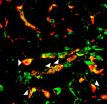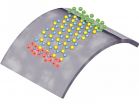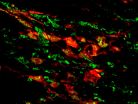Discovery of heart's repair process suggests new treatment strategy for heart attack
2014-10-15
(Press-News.org) UCLA researchers have discovered that some scar-forming cells in the heart, known as fibroblasts, have the ability to become endothelial cells — the cells that form blood vessels. The finding could point the way toward a new strategy for treating people who have suffered a heart attack, because increasing the number of blood vessels in the heart boosts its ability to heal after injury.
In studies involving mice, the UCLA team also found that a drug could enhance this phenomenon and improve the repair process after a heart attack.
The research is published in the October 15 online edition of the journal Nature.
Reversing or preventing scar tissue from forming has been one of the major challenges of cardiovascular medicine, said Dr. Arjun Deb, the study's senior author and an associate professor of medicine in the division of cardiology at the David Geffen School of Medicine at UCLA and the department of molecular, cell and developmental biology in the UCLA College of Letters and Science.
"It is well known that increasing the number of blood vessels in the injured heart following a heart attack improves its ability to heal," said Deb, who is also a member of UCLA's Eli and Edythe Broad Center of Regenerative Medicine and Stem Cell Research. "And we know that scar tissue in the heart is associated with a poorer prognosis. There is compelling clinical evidence to show that if you have more scar tissue in your heart, you are worse off. Our findings suggest the possibility of coaxing scar-forming cells in the heart to change their identity into blood vessel-forming cells, which could potentially be a useful approach for better heart repair."
Heart attacks remain a leading cause of death in the U.S. Each year, approximately 720,000 Americans suffer a heart attack — roughly one every 30 seconds — and about 380,000 people die from heart attacks.
Heart attacks typically are caused by a sudden blockage of the blood flow through a vessel in the heart. The portion of the heart muscle that fails to receive adequate blood dies and is replaced by non-functional scar tissue, a process known as fibrosis. Once a scar forms, it remains in the heart throughout the person's life.
Several years ago, Deb and his colleagues were investigating the relationship between fibroblasts and blood vessel–forming cells, or endothelial cells, which exist in close proximity in the injured heart. Through experiments in mice in which scar-forming cells in the heart were genetically labeled, the researchers discovered that many of the fibroblasts in the heart's injured region changed into endothelial cells and contributed directly to blood vessel formation — a phenomenon they called mesenchymal-endothelial transition, or MEndoT.
The researchers identified a molecular mechanism that regulated MEndoT and found that administering a small molecule to augment MEndoT led to less scarring and allowed the heart to heal more completely. They plan to test similar small molecules in other models to determine whether the strategy could potentially be used to benefit humans.
"There are remarkable similarities in the process of scarring in different organs after injury," Deb said. "Our hope is that this approach can be used to treat scar tissue in other organs as well."INFORMATION:
The study was supported by a grant from the National Institutes of Health (R01HL102190).
-UCLA-
ELSE PRESS RELEASES FROM THIS DATE:
Researchers develop world's thinnest electric generator
2014-10-15
New York, NY—October 15, 2014—Researchers from Columbia Engineering and the Georgia Institute of Technology report today that they have made the first experimental observation of piezoelectricity and the piezotronic effect in an atomically thin material, molybdenum disulfide (MoS2), resulting in a unique electric generator and mechanosensation devices that are optically transparent, extremely light, and very bendable and stretchable.
In a paper published online October 15, 2014, in Nature, research groups from the two institutions demonstrate the mechanical ...
UNC researchers boost the heart's natural ability to recover after heart attack
2014-10-15
CHAPEL HILL – Researchers from the UNC School of Medicine have discovered that cells called fibroblasts, which normally give rise to scar tissue after a heart attack, can be turned into endothelial cells, which generate blood vessels to supply oxygen and nutrients to the injured regions of the heart, thus greatly reducing the damage done following heart attack.
This switch is driven by p53, the well-documented tumor-suppressing protein. The UNC researchers showed that increasing the level of p53 in scar-forming cells significantly reduced scarring and improved heart ...
Post-tonsillectomy complications more likely in kids from lower-income families
2014-10-15
Removing a child's tonsils is one of the most common surgeries performed in the United States, with approximately 500,000 children undergoing the procedure each year. New research finds that children from lower-income families are more likely to have complications following the surgery.
In the first study of its kind to analyze post-operative complications requiring a doctor's visit within the first 14 days after tonsillectomy, researchers saw a significant disparity based on income status, race and ethnicity.
"Surprisingly, despite all children having a relatively ...
Tuning light to kill deep cancer tumors
2014-10-15
WORCESTER, MA – An international group of scientists led by Gang Han, PhD, at the University of Massachusetts Medical School, has combined a new type of nanoparticle with an FDA-approved photodynamic therapy to effectively kill deep-set cancer cells in vivo with minimal damage to surrounding tissue and fewer side effects than chemotherapy. This promising new treatment strategy could expand the current use of photodynamic therapies to access deep-set cancer tumors.
"We are very excited at the potential for clinical practice using our enhanced red-emission nanoparticles ...
Discovery of a new mechanism that can lead to blindness
2014-10-15
Montréal, October 15, 2014 – An important scientific breakthrough by a team of IRCM researchers led by Michel Cayouette, PhD, is being published today by The Journal of Neuroscience. The Montréal scientists discovered that a protein found in the retina plays an essential role in the function and survival of light-sensing cells that are required for vision. These findings could have a significant impact on our understanding of retinal degenerative diseases that cause blindness.
The researchers studied a process called compartmentalization, which establishes ...
Blinded by science
2014-10-15
Do you believe in science? Your faith in science may actually make you more likely to trust information that appears scientific but really doesn't tell you much. According to a new Cornell Food and Brand Lab study, published in Public Understanding of Science, trivial elements such as graphs or formulas can lead consumers to believe products are more effective. "Anything that looks scientific can make information you read a lot more convincing," says the study's lead author Aner Tal, PhD, "The scientific halo of graphs, formulas, and other trivial elements that look scientific ...
Weather history time machine
2014-10-15
During the 1930s, North America endured the Dust Bowl, a prolonged era of dryness that withered crops and dramatically altered where the population settled. Land-based precipitation records from the years leading up to the Dust Bowl are consistent with the telltale drying-out period associated with a persistent dry weather pattern, but they can't explain why the drought was so pronounced and long-lasting.
The mystery lies in the fact that land-based precipitation tells only part of the climate story. Building accurate computer reconstructions of historical global precipitation ...
Change your walking style, change your mood
2014-10-15
Our mood can affect how we walk — slump-shouldered if we're sad, bouncing along if we're happy. Now researchers have shown it works the other way too — making people imitate a happy or sad way of walking actually affects their mood.
Subjects who were prompted to walk in a more depressed style, with less arm movement and their shoulders rolled forward, experienced worse moods than those who were induced to walk in a happier style, according to the study published in the Journal of Behavior Therapy and Experimental Psychiatry.
CIFAR Senior Fellow Nikolaus ...
New guideline in genetic testing for certain types of muscular dystrophy
2014-10-15
Rochester, Minn. – The American Academy of Neurology (AAN) and the American Association of Neuromuscular & Electrodiagnostic Medicine (AANEM) offer a new guideline on how to determine what genetic tests may best diagnose a person's subtype of limb-girdle or distal muscular dystrophy. The guideline is published in the October 14, 2014, print issue of Neurology®, the medical journal of the AAN.
Researchers reviewed all of the available studies on the muscular dystrophy, a group of genetic diseases in which muscle fibers are unusually susceptible to damage, as ...
Eating breakfast increases brain chemical involved in regulating food intake and cravings
2014-10-15
COLUMBIA, Mo. – According to the Centers for Disease Control and Prevention (CDC), many teens skip breakfast, which increases their likelihood of overeating and eventual weight gain. Statistics show that the number of adolescents struggling with obesity, which elevates the risk for chronic health problems, has quadrupled in the past three decades. Now, MU researchers have found that eating breakfast, particularly meals rich in protein, increases young adults' levels of a brain chemical associated with feelings of reward, which may reduce food cravings and overeating ...



